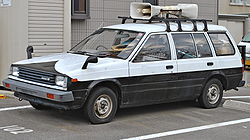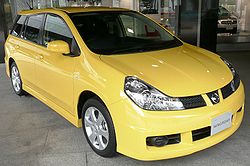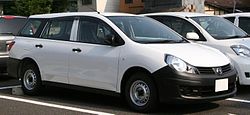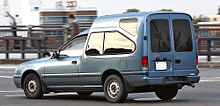- Nissan Wingroad
-
- This article incorporates information from the equivalent article on the Japanese Wikipedia.
The Nissan Wingroad is an automobile available only as a compact station wagon. The Wingroad is sold as a different name when manufactured as a commercial delivery van, called the Nissan AD van, or as it's known as the (Japanese: Nissan AD Van). It is an alternative to the Honda Partner commercial delivery van in Japan.
Contents
VB11 series
Nissan AD van VB11 
Predecessor Nissan Sunny Van
Nissan Pulsar Van
Nissan Auster/Violet VanBody style 3/5-door wagon Engine 1.3 L E13S I4
1.5 L E15S I4
1.7 L CD17 diesel I4Wheelbase 2,400 mm (94.5 in) Length 4,085–4,110 mm (160.8–161.8 in) Width 1,620 mm (63.8 in) Height 1,465 mm (57.7 in) In October 1982, the AD van supplemented (and also gradually replaced) the commercial delivery vans from Nissan's other vehicles. In 1983, the Nissan Cedric van was discontinued, as was the Nissan Gloria van. It originally came with two front doors and a liftback hatch in back. It was based on the B11 series Nissan Sunny wagon but has a more square-rigged and utilitarian appearance.
The rear suspension was designed for commercial usage, so it used a simple leaf spring setup and wasn't intended for ride quality. Low cost, light weight, and a flat, low loading floor were the main consideration. The AD van was designed for very basic duties, and the options list was kept small to enhance economical use and running costs. The AD van used a front wheel drive engine configuration shared with the Sunny.
It came with three engines; the 1.5 L and 1.3 L carburetted E15S and E13S and the 1.7 L CD17 diesel engine. The transmissions were either a four- or five-speed manual transmission, with the availability of a three-speed automatic for the bigger of the gasoline options.
In July 1983, two more doors were added to streamline manufacturing costs, and it could be installed with an optional back seat. The AD van remained basically unchanged, except for minor cosmetic changes until the second generation was introduced in 1990 with the Y10 series.
Y10 series
The first generation (Y10) replaced the Nissan Sunny B13 series wagon and was introduced October 1990, but with a different rear end compared to the standard Sunny wagons that were exported. The vehicle continued as the AD van, and as a private use (non-commercial) it was marketed as the Nissan Sunny California wagon (N14/Y10). The engines used were the 1.5 L and 1.3 L GA15DS & GA13DS with DOHC and the 1.7 L CD17 diesel continued. The Wingroad/AD van were also accompanied by a larger retail/commercial station wagon/delivery van called the Nissan Avenir/Expert that replaced the Nissan Bluebird U12 wagon/delivery van.
In 1996 the Nissan Wingroad was added to the lineup. The Wingroad was offered with the SR20DE instead of the GA13DS, as well as the SR18DE and GA15DE. Trying to cash in on Japan's RV ("recreational vehicle", usually feel versions of existing vans and wagons combining a slight off-road vibe with sportier equipment) craze of the late 1990s. The Wingroad followed this recipe closely, being a winged and bespoilered version of the AD Van with usually more powerful engines. Four-wheel drive was optional. What is uncommon about the Wingroad is that it also received a redesigned, larger rear end with a longer rear overhang. The Wingroad name was borrowed from a trim grade on the Nissan Bluebird U11 series wagon.
April 1992 saw the introduction of the AD Max with an unusual raised cargo bay, called fourgonette style, with two French doors in back and two doors for front passengers. The wheelbase was extended 70 mm to 4,270 mm, with the height of the cargo area measured to be 1,810 mm. Two rear wipers were installed on each of the French doors. Suzuki also tried this approach with the Suzuki Alto Hustle. The AD Max was available with regular rectangular side windows or a more unusual triangular arrangement (pictured), as well as a panelled version of the latter.
August 1993 saw minor changes, with the 1.3 L automatic transmission upgraded to a four-speed. The Wingroad transmission selections were either the four-speed automatic or a five-speed manual.
The Wingroad JS trim level shares an appearance with the larger Nissan Avenir Blastar, and both also use a two tone paint scheme.
September 1993 The AD van was introduced to Thailand, Taiwan and Malaysia called the Nissan AD Resort. A "Wingroad" version was also available in Thailand, but unlike the Japanese market Wingroad this is a Y10 based pickup truck. The AD Wagon was sold in Mexico, called the Nissan Tsubame (which, with the T removed, means "get me on top" in Spanish, and swallow - the bird - in Japanese).
August 1994, the AD van was sold as the Subaru Leone sold as a light commercial vehicle until model year 2001 Y11 series for Subaru. The Subaru version was added as a result of the Leone platform having been replaced by the Subaru Impreza which had a reduced size cargo area on the wagon/five-door hatchback. The Mazda Familia was introduced at the same time and is still in production using the current Y12 series.
April 1996 saw a driver side airbag added as an extra cost option.
May 1997 saw minor cosmetic changes. The 1.3 L & 1.5 L GA13DE & GA15DE engines replaced the GA13DS and GA15DS for better emissions performance. the 2.0 L CD20 diesel engine was introduced with the ATTESA 4WD system, and ventilated front disc brakes were introduced on all trim levels. The front windshield wipers were offered with a de-icer option.
Y11 series
The second series (Y11) began May 31 1999, once again available only with a station wagon body, sold in the Japanese, New Zealand (as a Sunny) and Caribbean markets. It is mechanically related to the Nissan Sunny B15 series but has a different exterior design. The interior design is shared with the Japanese market Nissan Sunny B15 as well. The second generation Wingroad received a face-lift in 2001, with a sleeker front end and a new interior.
The Wingroad version slotted in Nissan's product range between the Nissan Bluebird and the Primera, available with the 1.5 L QG15DE, the 1.8 L QG18DE and the 2.0 L SR20VE engines. The 1.8 L exists only as a 4WD version.
The Wingroad shares a MacPherson strut front suspension with the other Nissan C-Segment cars of the era, such as the B15 Sunny/Sentra and the N16 Almera/Pulsar. In most models, the rear suspension consisted of a beam axle with coil springs and panhard rod. The four-wheel drive versions and the ZV-S FWD variant used a multi-link rear suspension. All variants were fitted with ventilated disc brakes in the front and drum brakes in the rear; the exception being the ZV-S which was fitted with non-ventilated disc brakes in the rear.
October 24 2000, the Wingroad was offered as a trim level called "G Extra" that included an optional TV screen that folded down from the ceiling for rear passengers.
March 2001, manufacturing operations were moved from the Nissan Shatai factory in Kyoto to the facility in Shonan. The 2.0 L SR20VE engine is replaced with the 2.0 L QR20DE. Various trim level packages were introduced on the Wingroad approximately every six months, including aero packages and limited offering names, such as "Aero Sport Limited".
The commercial AD van version continued to be also sold as the Mazda Familia wagon. It is unrelated to the Familia passenger car range, and kept the Familia name after the car range was replaced by the Mazda3. Engines available for the AD van were the 2.2 L YD22 diesel, 1.3 L QG13DE, the 1.5 L QG15DE, and the 1.8 L QG18DE (with dedicated 4WD) that was upgraded to the QG18DEN designed to run on CNG for emissions reduction on January 14, 2000. The CNG option achieved 1000 sales by July 24, 2002, however, CNG vehicles were no longer offered by December 3, 2008. The diesel engine was discontinued in 2001 as Japan actively discouraged the use of diesel vehicles within its cities.
A driver-side airbag is now standard on both the AD van and the Wingroad, with a passenger-side airbag optional.
The AD van Max was no longer offered.
Y12 series
Nissan Wingroad / AD van Y12 

Manufacturer Nissan Also called Mazda Familia van
Mitsubishi Lancer CargoProduction 2006-present (Y12 series) Assembly Samut Prakarn, Thailand[1]
Kanda, Japan (Nissan Shatai)Class compact Body style 5-door wagon Layout Front engine, front-wheel drive / four-wheel drive Engine 1.2 L CR12DE l4
1.5 L HR15DE l4
1.6 L HR16DE I4
1.8 L MR18DE I4Transmission 5-speed manual
4-speed automaticWheelbase 2,600 mm (100 in) Length 4,395 mm (173.0 in) Width 1,695 mm (66.7 in) Height 1,500 mm (59 in) Related Nissan Tiida An all-new AD van (Y12) debuted December 20 2006, now sharing its platform with the Nissan Sunny replacement Nissan Tiida. The Wingroad debuted November 14 2005, with a preview at the 39th Tokyo Motor Show in October. Like the Tiida, it has a wheelbase of 2,600 mm, and the new HR15DE and MR18DE engines along with the CR12DE. While the Wingroad was available with 4WD from the beginning, the AD Vans originally only came with front-wheel drive. The transmission for the AD van and the Wingroad is a four-speed automatic or the optional CVT. From 2007 there is also a new Familia Cargo, based on the Y12 shape AD van. The Y12 was introduced in late December 2008 as the (Japanese: Mitsubishi Lancer Cargo).
The Wingroad received limited edition trim level packages, called "Rider α II", "Sport Acapello", "V Selection" to name a few. When the Nissan Stagea was discontinued June 2007, the Wingroad/AD van was the only station wagon still built by Nissan, with Nissan instead introducing a number of new MPV's, such as the Nissan Lafesta, the Nissan Presage, and the Nissan Elgrand. In December of 2008, the AD Van is now available with the HR16DE engine and the e4WD all wheel drive system. In the same month, the last of the preceding Y11 series were finally taken out of production; CNG and 4WD versions of the Y11 had been built in parallell for a few years after the Y12 was introduced.
Intelligent Key was added to the Wingroad September 11 2006, and the Wingroad can be equipped with a GPS navigation package using HDD technology. The AD Van had been sold without passenger side airbag, but from May 2009 this became standard across the range.
Y13 series
References
- ^ "Nissan. Nissan In Thailand". Car-cat.com. http://car-cat.com/firm-1139.html. Retrieved 2010-07-25.
External links
- Nissan Wingroad official page
- WEB Archive No. Wingroad (Y11-period)
- WEB Archive No. Wingroad (Y11-late)
- Wingroad Information
- Modified Nissan AD Resort Y10 Year 1995
Nissan Motor Company Vehicles Current370Z • Advan • Altima • Aprio • Armada • Atlas • Bluebird • Bluebird Sylphy • Cabstar • Caravan • Civilian • Clipper • Cube • Dualis • Elgrand • Frontier • Freeson • Fuga • GT-R • Juke • Lafesta • Leaf • Livina Geniss • Maxima • March • Murano • Moco • Navara • Note • NV200 • NV400 • Otti • Paladin • Pathfinder • Patrol • Qashqai • Quest • Rogue • Safari • Sentra • Serena • Skyline • Teana • Tiida • Titan • Urvan • Versa • Wingroad • X-Trail • XterraPastDC-3 • 100NX • 1200 • 310 • 180SX • 200SX • B-210 • 240SX • 240Z • 280ZX • 300C • 300ZX • 350Z • 510 • 810 • Almera • Almera Tino • Altra (EV) • Avenir • Auster • Bassara • Be-1 • Caball • Cablight • Cedric • Cefiro • Cherry • Cima • Crew • Datsun Truck • Echo • Expert • Fairlady • Figaro • Gazelle • Gloria • Hardbody Truck • Hypermini • Homy • Interstar • Junior • Largo • Laurel • Leopard • Liberty • Mistral • Multi • NX • Pao • Pintara • Pino • Platina • Prairie • Presage • Presea • Primera • President • Pulsar • Pulsar GTI-R • R390 GT1 • R'nessa • Rasheen • Roadster-Road Star • S-Cargo • Saurus • Saurus Jr • Silvia • Sileighty • Skyline GT-R • Stanza • Stagea • Sunny • Terrano • Terrano II • Vanette • VioletConcept126X • 216X • 270X • 300 Bambu • 315-a • AA-X • Actic • AD-1 • AD-2 • AL-X • Alpha T • Amenio • AQ-X • AP-X • ARC-X • AXY • AZEAL • Bevel • Boga • C-Note • Chapeau • Chappo • Cocoon • CQ-X • Crossbow • CUE-X • Cypact • Duad • Dunehawk • Effis • ESV • Evalia • EV Guide II • EV Truck • FEV • FEV-II • Foria • Forum • Fusion • Gobi • GR-1 • GR-2 • GT-R • ideo • Intima • Jikoo • Judo • Jura • Kino • KYXX • Land Glider • LEAF • LUC-2 • MID4 • Mixim • mm.e • Moco • Nails • NCS • NEO-X • NRV-II • NX-21 • NV2500 • Pivo • Pivo 2 • Qazana • Redigo • Round Box • Serenity • Sport Concept • Stylish VI • Terranaut • Tone • Townpod • Trailrunner • TRI-X • URGE • UV-X • XIX • XVL • Yanya • ZarootEngines GRX-3 • UD12 • VRT35Marques Nissan • InfinitiSubsidiaries
and divisionsSee also ATTESA • Datsun • HICAS • Prince • Renault-Nissan Alliance • Nissan Shatai • UD Nissan Diesel • VVL • VVEL • dCi
 Category ·
Category ·  CommonsCategories:
CommonsCategories:- Nissan vehicles
- Vehicles introduced in 1982
- All wheel drive vehicles
- Station wagons
- 1980s automobiles
- 1990s automobiles
- 2000s automobiles
Wikimedia Foundation. 2010.










